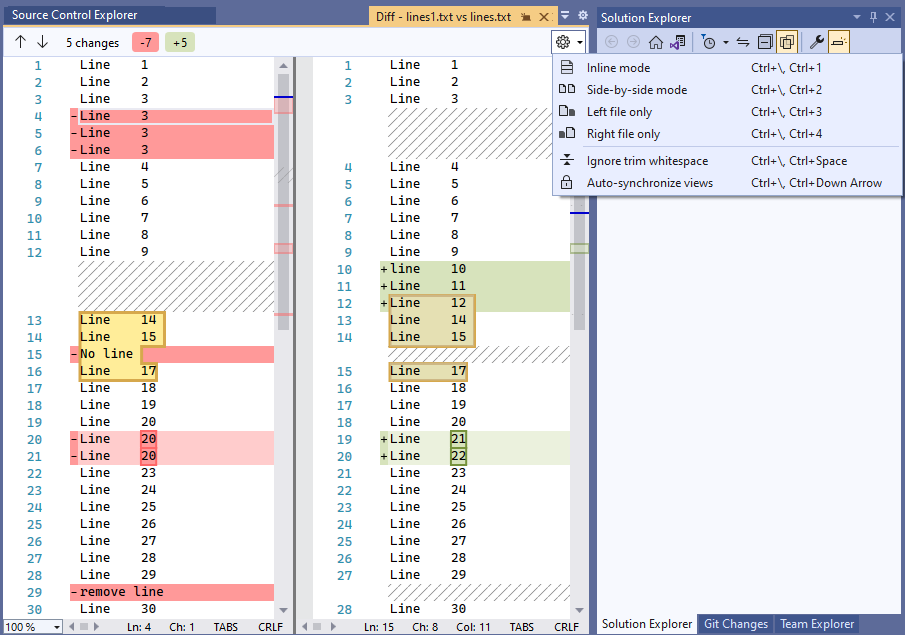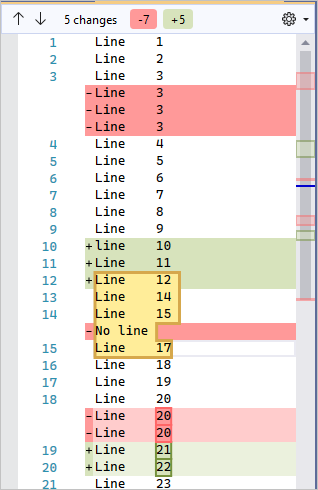Compare files using Team Foundation Version Control
TFS 2018
Visual Studio 2019 | Visual Studio 2022
This article provides a guide for comparing files when using Team Foundation Version Control (TFVC). If you're using Git for version control, see Compare files.
You can compare server folders and local folders to each other, and view the differences between the contents of each folder. You can compare two server files, two local files, or a server file against a local file, and view the differences between the files.
You can merge changes between two versions by copying and pasting changes from the diff view into your workspace version to quickly bring in updates from one version to another.
Note
Even if you're not using version control, you can use the Diff window in Visual Studio to compare any two files on your computer. Use the devenv.exe tool with the /diff option from the Developer Command Prompt to open the Visual Studio Diff window to compare the files.
Compare any two files using the Compare dialog box
You can compare any two files using the Visual Studio Compare dialog box. The files can both reside on the local system, both on Azure DevOps Server, or one on each.
On the menu bar, choose View > Other Windows > Source Control Explorer.
In Source Control Explorer, right-click a file and select Compare.
In the Compare dialog box, select the files to compare. Enter a path and filename under both Source path and Target path, or select the arrow next to Browse, choose Local Path or Server Path, and then browse to choose the file.
Tip
To compare any two local files, select Local Path from both Browse dropdown menus.
Under Source version, next to Type, select Changeset, Date, Label, Latest Version, or Workspace Version, and specify the details.
Select OK.
Compare files in your workspace with the most recent version
Compare your work with the latest version on Azure DevOps Server while continuing to make changes.
If you aren't already connected to the project that you want to work in, connect to the project.
From Team Explorer, open the Pending Changes page.
On the Pending Changes page, locate the file in the Included Changes list.
Right-click the file and select Compare with Workspace Version to see the local changes you've made to the version you checked out.
Tip
You can also press Shift and then double-click the file.
Or, right-click the file and select Compare with Latest Version to compare your changes to the latest version of the file on Azure DevOps Server.
The Diff window appears. You can continue to make changes to the file in this window.
Tip
You can also use Solution Explorer or Source Control Explorer to compare a file in your workspace with a version of the file on the server. Right-click a file and select Compare. When the Compare dialog box appears, select OK.
Compare two versions of a file in your TFVC history
Compare two versions of a file already checked into Team Foundation Version Control:
On the Visual Studio menu bar, select View > Other Windows > Source Control Explorer.
In Source Control Explorer, right-click a file and select View History.
In the History window, select two versions of the file, right-click and select Compare.
Use the Diff window
When you compare files using the instructions in the previous sections, Visual Studio displays the files in the Diff window. The Diff window shows the difference between two files. If one of the files is checked out in your workspace, you can modify the file as you run the comparison.
In the Diff window:
- Lines that are being deleted have a red background in the source, and are replaced by shading in the changed version.
- Lines that are being added appear as shading in the source, and have a green background in the changed version.
- Lines that are being changed have a red background in the source and a green background in the changed version.
- Lines that have code review comments are outlined and have a yellow background.
- The scroll bars next to each version show a visual summary of the differences between the files.

Select the arrow icons at the upper-left of the Diff window, or press F8, to skip back and forth between diffs.
To go back and forth in the files, select places on the visual summary scroll bars.
Select the arrow next to the Settings icon at the top of the Diff window to change the view. Side-by-side mode is more effective in most cases, but you can also use Inline mode, or view the Left file only or Right file only.
The following screenshot shows inline view:

When you participate in a code review, you use the Diff window to see the code changes that are the subject of the review. For more information, see Suspend work, fix a bug, and conduct a code review.
Merge changes between versions
You can copy and paste changes from the diff view into your workspace version to quickly bring in updates from one version to another. Merge more complex changes between two versions when you resolve merge conflicts in TFVC before you check in changes.
If you need to merge two files with significant differences outside of TFVC conflict resolution, use the vsdiffmerge command line tool. The vsdiffmerge tool allows you to merge changes side-by-side and pick which contents you want to keep for each difference between the files.
Run the command from the Visual Studio Developer Command Prompt with four file parameters followed by the /m flag to bring up the merge tool directly against any two files. The basic syntax for vsdiffmerge.exe is:
vsdiffmerge.exe "File1" "File2" "Base file" "Result file" /m
File1 and File2 are the full path to the files you want to merge. The Base file is the full path to the file both files are based off, and the Result file is the full path where you want to write the merged results.